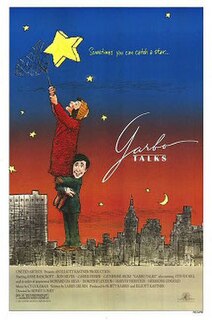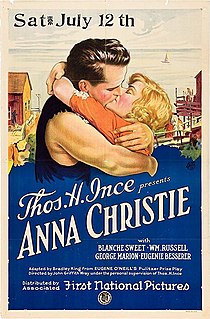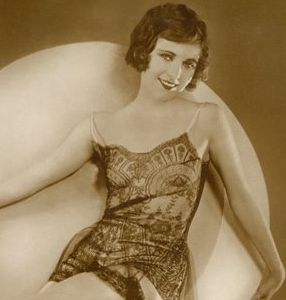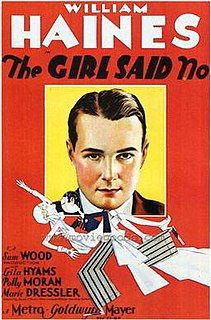See also
| This disambiguation page lists articles associated with the title Anna Christie. If an internal link led you here, you may wish to change the link to point directly to the intended article. |
Anna Christie is a 1921 play by Eugene O'Neill.
Anna Christie may also refer to the adaptations:
| This disambiguation page lists articles associated with the title Anna Christie. If an internal link led you here, you may wish to change the link to point directly to the intended article. |

Greta Garbo was a Swedish film actress during the 1920s and 1930s. In 1999, the American Film Institute ranked Garbo fifth on their list of the greatest female stars of classic Hollywood cinema.

Anna Christie is a play in four acts by Eugene O'Neill. It made its Broadway debut at the Vanderbilt Theatre on November 2, 1921. O'Neill received the 1922 Pulitzer Prize for Drama for this work.

Romance is a 1930 American Pre-Code Metro-Goldwyn-Mayer film directed by Clarence Brown, starring Greta Garbo, Lewis Stone, and Gavin Gordon.
Camille may refer to:
La Dame aux Camélias is a novel by Alexandre Dumas fils, first published in 1848 and subsequently adapted by Dumas for the stage. La Dame aux Camélias premiered at the Théâtre du Vaudeville in Paris, France on February 2, 1852. The play was an instant success, and Giuseppe Verdi immediately set about putting the story to music. His work became the 1853 opera La traviata, with the female protagonist, Marguerite Gautier, renamed Violetta Valéry.

Salka Viertel was an Austrian actress and screenwriter. Viertel was born Salomea Sara Steuermann in Sambor, a city then in the province of Galicia, which was a part of the Austro-Hungarian Empire, but today is in western Ukraine. Viertel was under contract with Metro-Goldwyn-Mayer from 1933 to 1937, and co-wrote the scripts for many movies, particularly those starring her close friend Greta Garbo, including Queen Christina (1933) and Anna Karenina (1935). She also played opposite Garbo in MGM's German-language version of Anna Christie in 1930.

Garbo Talks is a 1984 American comedy-drama film directed by Sidney Lumet and starring Anne Bancroft, Ron Silver, and Carrie Fisher, with a cameo appearance by Betty Comden as Greta Garbo.

Camille is a 1936 American romantic drama film from Metro-Goldwyn-Mayer directed by George Cukor, and produced by Irving Thalberg and Bernard H. Hyman, from a screenplay by James Hilton, Zoë Akins, and Frances Marion. The picture is based on the 1848 novel and 1852 play, La Dame aux Camélias, by Alexandre Dumas, fils. The film stars Greta Garbo, Robert Taylor, Lionel Barrymore, Elizabeth Allan, Jessie Ralph, Henry Daniell, and Laura Hope Crews. It grossed $2,842,000.

Anna Karenina is a 1935 Metro-Goldwyn-Mayer film adaptation of the novel Anna Karenina by Leo Tolstoy and directed by Clarence Brown. The film stars Greta Garbo, Fredric March, Basil Rathbone and Maureen O'Sullivan. There are several other film adaptations of the novel.

Anna Christie is a 1930 Metro-Goldwyn-Mayer pre-Code drama film adaptation of the 1922 play of the same name by Eugene O'Neill. It was adapted by Frances Marion, produced and directed by Clarence Brown with Paul Bern and Irving Thalberg as co-producers. The cinematography was by William H. Daniels, the art direction by Cedric Gibbons and the costume design by Adrian.

Anna Christie is a 1923 American silent era drama film based on the 1921 play by Eugene O'Neill, starring Blanche Sweet and William Russell.

Anna Christie is a 1930 German-language film adapted from the Eugene O'Neill play of the same title and filmed following the release of the English-language original version of the same adaptation earlier the same year. Both versions feature leading actress Greta Garbo. In the early years of sound films, Hollywood studios produced foreign-language versions of some of their films using the same sets and sometimes the same costumes, with native speakers of the language usually replacing some or all of the original cast. The German-language version of Anna Christie is one of the few that survives.

Love (1927) is a silent film directed by Edmund Goulding and released by Metro-Goldwyn-Mayer. MGM made the film in order to capitalize on its winning romantic team of Greta Garbo and John Gilbert who had starred in the 1926 blockbuster, Flesh and the Devil.
This is a list of adaptations of Anna Karenina, the novel by Leo Tolstoy.
George Marion Jr. was an American screenwriter. He wrote for 106 films between 1920 and 1940. He was born in Boston, Massachusetts and died in New York, New York from a heart attack. His father was George F. Marion (1860-1945), a stage actor, stage director and film actor who is best remembered as Greta Garbo's father Chris in the early sound classic Anna Christie (1930). He was nominated at the 1st Academy Awards in the category of Best Title Writing, which was the only year it was presented.

George F. Marion Sr. was an American stage actor and director, a film actor and director of two silent films. Marion acted in 35 films between 1915 and 1935. He is best remembered for playing the father Chris Christopherson to the Broadway production of Anna Christie of Pauline Lord and the two film versions of Anna Christie of Blanche Sweet and Greta Garbo. His son George Marion, Jr. was a famous Hollywood screenwriter. Marion died in Carmel, California in 1945, at the age of 85.

Frances Lee was an American film actress during Hollywood's silent film era, and well into the sound film era of the 1930s.

Inspiration is a 1931 American Pre-Code Metro-Goldwyn-Mayer film adapted from the Alphonse Daudet short novel Sappho (1884). The film was adapted by Gene Markey, directed by Clarence Brown and produced by Irving Thalberg. The cinematography was by William H. Daniels, the art direction by Cedric Gibbons and the costume design by Adrian.

The Girl Said No is a 1930 pre-Code American romantic comedy film starring William Haines and Leila Hyams. In the film, a young college graduate goes to extreme lengths to win the girl he loves.
A multiple-language version film, often abbreviated to MLV, is a film, especially from the early talkie era, produced in several different languages for international markets. To offset the marketing restrictions of making sound films in only one language, it became common practice for American and European studios to produce foreign-language versions of their films using the same sets, crew, costumes, etc. The first foreign-language versions appeared in 1929 and largely replaced the International Sound Version method for many major releases. The most common languages used for these productions were English, Spanish, French and German.